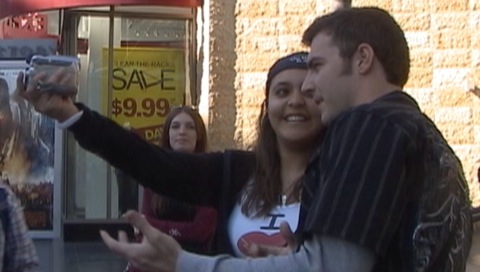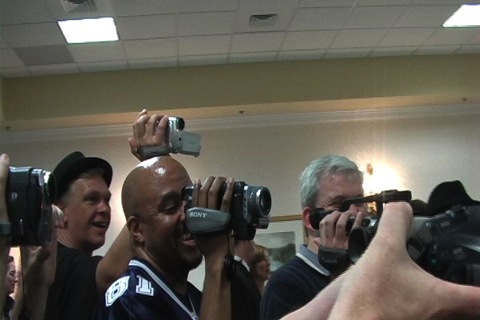Hey Watch This! Sharing the Self Through Media
Produced, Directed, and Edited by: Patricia G. Lange
Release Date: February 26, 2020
Length: 54 minutes
See the trailer on Vimeo and YouTube!
See the full length version on Vimeo!
Click here to access the film's Study Guide.
Click here to access the film's Transcript.

Throughout the film, participants discuss their views on mediated communities and their surprisingly diverse reasons for making media. A number of enduring and philosophical themes emerge, including locating the "real me" in and through media, selecting media, digital migration, attitudes and responsibilities towards viewers, strategies for dealing with online harassment, comparisons to media of the past, and reflections on participants’ mediated legacies after people pass away. The filmmaker, an anthropologist, became part of a YouTube community of interest and traveled to numerous meet-ups in locations such as New York City, Hollywood, Santa Monica, San Diego, San Francisco, Minneapolis, Toronto, Philadelphia, and Marietta, Georgia to observe and interact with YouTubers as they came together and discussed their views about participating on YouTube. The film chronicles how and under what circumstances people chose particular media to express the self, including text comments, videos, live video chat, photographs, and micro-blogging. Although mainstream media discourses often consider video making and online participation to somehow exist outside of “real life,” the film depicts the intricate interweaving between in-person and mediated interaction. In addition, interviewees often explained how their media poignantly captured core aspects of the self that were not always available to friends, family, or even themselves at certain difficult moments of their lives.

Thematically-driven rather than character-oriented, the film uses dialectic montage to juxtapose divergent viewpoints on how people mediate themselves. For example, given that people can actively participate through comments, some participants believe that it is not important to show their faces. Yet, others feel a warmer sense of connection when YouTubers appear on camera. These contrasting views inevitably invite viewers’ self-reflection not only about their own media choices, but the ways in which people represent each other and draw others into social interactions in creatively mediated ways. The ethnographer’s insider perspective weaves together multiple threads to offer a unique look at how people are learning new forms of media literacies, and how we are all increasingly relating to others through media.
Director’s Bio: Patricia G. Lange, Ph.D. is an Anthropologist and Associate Professor of Critical Studies at California College of the Arts (CCA) in San Francisco. Recognized as an expert in studies of new media and YouTube, her work focuses on technical identity performance and use of video to creatively express the self. Her new book is called Thanks for Watching: An Anthropological Study of Video Sharing on YouTube (University Press of Colorado, 2019), which draws on a multi-year, deeply engaged ethnographic project on YouTube and video bloggers to explore how people use video to engage in sociality. Her prior book was Kids on YouTube: Technical Identities and Digital Literacies (Routledge, 2014), which focused on how young people develop digital skills by participating on YouTube. Her ethnographic film Hey Watch This! Sharing the Self Through Media (2020) provides a unique diachronic look at the rise and fall of YouTube as a social media site among one group of YouTubers, and offers a poignant look at how participants envision their digital legacies. Lange is an expert on new media and digital ethnography, and has been widely published in a variety of journals on social uses of YouTube. She is also a co-author of two books, Hanging Out, Messing Around, and Geeking Out: Kids Living and Learning with New Media (2010), and Living and Learning with New Media: Findings from the Digital Youth Project (2009), both published by The MIT Press. At CCA, she teaches courses on digital cultures; anthropology of technology; new media and civic action; and ethnography for design. She has served as an invited speaker at the International Film Festival Rotterdam and the Transforming Audiences 3 Conference in London. Prior to joining CCA, she was a Postdoctoral Fellow at the Institute for Multimedia Literacy in the School of Cinematic Arts at the University of Southern California. Currently, she is researching the genre of video rants as civic engagement, and issues of safety on social media.
Sample Discussion Questions
[For additional questions and exercises organized by theme, consult the study guide posted above.]
This film stimulates fascinating ethnographic and self-observational questions about people’s contemporary media use. Discussion questions emerging from the film include:
1. Are you more your real self in a particular medium, offline, or somewhere in between?
2. Are you more your real self in certain media versus others?
3. What media do you choose for particular contexts?
4. When do you switch media?
5. Do you interact online mostly with people you already know, or do you make new friends online?
6. Do you feel the need to appear on camera when you make videos? Why or why not?
7. Has a friend ever started a social media account for you? Did you continue it? Explain.
8. Have you ever been harassed online? How did you deal with it? Did you notify organizers or did you deal with it on your own?
9. What does it mean to be safe online today?
10. Have you noticed changes in your online media habits? Have you changed social media sites as you have gotten older?
11. What techniques does the film use to portray a computer-based experiences in cinematic form?
12. How do the film’s aesthetics portray the look and feel of participating online?
13. Have you ever felt upset when other people have not included you in their media?
14. Is it important to develop online self-presentation skills or should you “just be yourself” in videos? Is “being yourself” on camera considered a skill?
15. Interviews and events anchor the ethnographic film. What kinds of “events” are considered in this film? How do media weave through these events?
16. What evidence does the film provide that YouTube is a website, network, community, and/or a state of mind?
17. How is YouTube a main character in the film?
18. What kinds of events and interactions challenge the notion that YouTube or other online sites can foster community?
19. How does the film illustrate or prompt reconsideration of past scholarship on mediated identity and community?
20. How did people learn to make videos?
21. What counts as full "participation" on YouTube? What counts as participation in the other sites you use?
22. Susan Sontag once wrote, “All photographs are memento mori,” in that they expose people’s vulnerability and mortality. Do you agree that the same is true about video?
23. What do you envision for your digital legacy? Should your media remain or be deleted?
24. When and for what reasons do you migrate away from a site?
25. What kind of platform would you design for your future social media use?